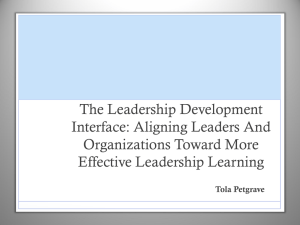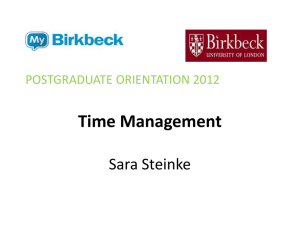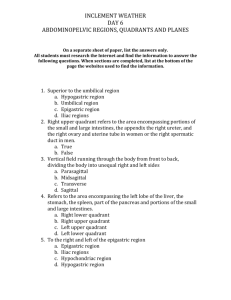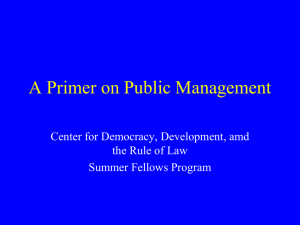Are You Happy? Personal Management Styles that Kill Stress
advertisement
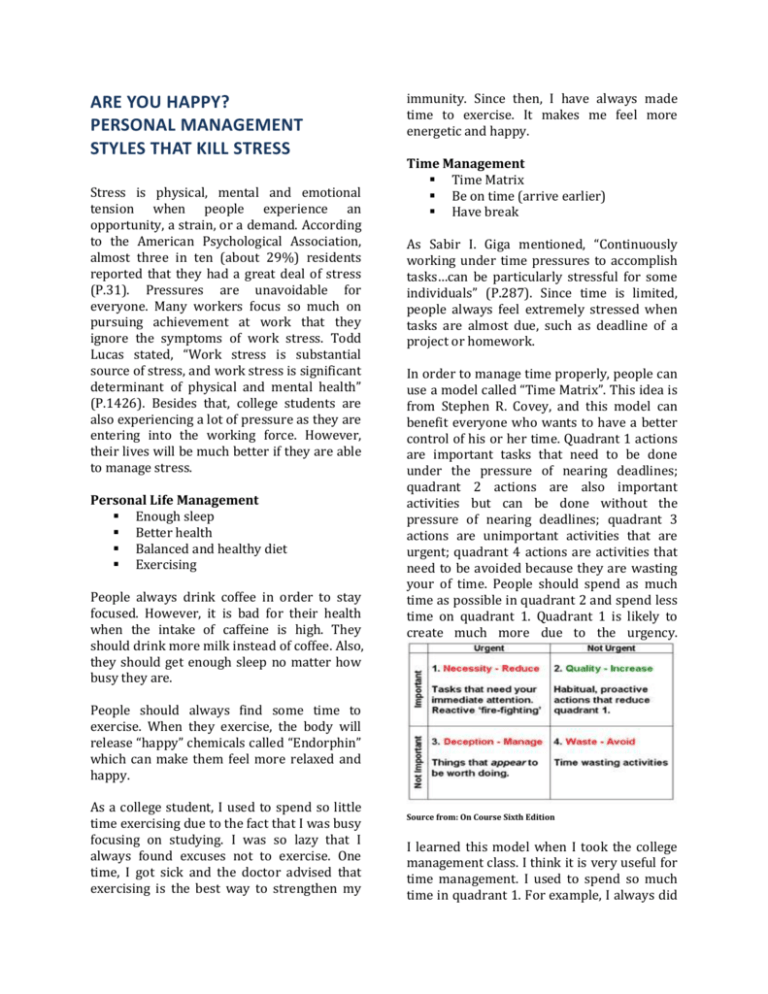
ARE YOU HAPPY? PERSONAL MANAGEMENT STYLES THAT KILL STRESS Stress is physical, mental and emotional tension when people experience an opportunity, a strain, or a demand. According to the American Psychological Association, almost three in ten (about 29%) residents reported that they had a great deal of stress (P.31). Pressures are unavoidable for everyone. Many workers focus so much on pursuing achievement at work that they ignore the symptoms of work stress. Todd Lucas stated, “Work stress is substantial source of stress, and work stress is significant determinant of physical and mental health” (P.1426). Besides that, college students are also experiencing a lot of pressure as they are entering into the working force. However, their lives will be much better if they are able to manage stress. Personal Life Management Enough sleep Better health Balanced and healthy diet Exercising People always drink coffee in order to stay focused. However, it is bad for their health when the intake of caffeine is high. They should drink more milk instead of coffee. Also, they should get enough sleep no matter how busy they are. immunity. Since then, I have always made time to exercise. It makes me feel more energetic and happy. Time Management Time Matrix Be on time (arrive earlier) Have break As Sabir I. Giga mentioned, “Continuously working under time pressures to accomplish tasks…can be particularly stressful for some individuals” (P.287). Since time is limited, people always feel extremely stressed when tasks are almost due, such as deadline of a project or homework. In order to manage time properly, people can use a model called “Time Matrix”. This idea is from Stephen R. Covey, and this model can benefit everyone who wants to have a better control of his or her time. Quadrant 1 actions are important tasks that need to be done under the pressure of nearing deadlines; quadrant 2 actions are also important activities but can be done without the pressure of nearing deadlines; quadrant 3 actions are unimportant activities that are urgent; quadrant 4 actions are activities that need to be avoided because they are wasting your of time. People should spend as much time as possible in quadrant 2 and spend less time on quadrant 1. Quadrant 1 is likely to create much more due to the urgency. People should always find some time to exercise. When they exercise, the body will release “happy” chemicals called “Endorphin” which can make them feel more relaxed and happy. As a college student, I used to spend so little time exercising due to the fact that I was busy focusing on studying. I was so lazy that I always found excuses not to exercise. One time, I got sick and the doctor advised that exercising is the best way to strengthen my Source from: On Course Sixth Edition I learned this model when I took the college management class. I think it is very useful for time management. I used to spend so much time in quadrant 1. For example, I always did study one day prior to my exam. After I learned this model, I spent more time in quadrant 2 instead of in quadrant 1. That means I study regularly instead of just studying on one day prior to my exam. As a result, my grades keep improving. There are some other suggestions to reduce stress that is caused by time constraint. For instance, people would better arrive 15 minutes earlier before work/school. This makes them have less feeling or pressure of time constrain. They can also use the 15 minutes to mentally “adjust” to the environment. Furthermore, taking a break is necessary in order to avoid breaking down. This is especially important when people have a very heavy workload. Task Management Priority Dividing big tasks/ projects Cooperation No procrastination In a workplace, people should do the work that requires most research and effort first. Also, if they have a big project, they should divide it in different parts, then, they can finish the project step by step. They should cooperate with others because putting too much burden on themselves is likely to create a lot of pressures. It’s important to keep in mind that people should not do their work at the last minute. Don't procrastinate! Procrastination generates the feeling of worry. Sarah DeArmond suggested that people who procrastinate are likely to suffer from more health problems, and they tend to have low performance (P.139). Frankly speaking, I do not like group projects because it is always difficult to find a perfect time to work with group members. That is why I am extremely stressed whenever I have group project. Therefore, cooperation is very important for task management in order to release pressure. Emotion Management Social support Manage conflict In order to maintain a good relationship with family, friends, classmates, colleagues, boss, and so on, people need to control their emotions. Seeking support from a social cycle is an effective way. When people suffer from psychological problems from work pressure, they can talk to someone that they trust. Besides that, referring to “ ‘People-Work’: Emotion Management, Stress and Coping” by Sandi Mann, people need a quick break whenever they have emotional instability. That is called “downtime” or “time-out”. It is also useful to take a breath when they feel stressed (P.251). There are many ways to seek support in college. Seeking help from counselors is the best way because they are very professional and experienced. Also, there is health center in almost every college. Hence, students should always take advantage of all these resources that they have. Personally, I prefer talking to my friends because I think they understand me a lot. Some of my friends also have the similar problems that I encounter. Therefore, we can help each other out. This is really good for our friendship in the long run. Conclusion Everyone has pressure. The main point is whether people know how to turn stress to “eustress”– a positive and good stress (Mann P.93). In fact, many U.S organizations realized that it is important to help employees mitigate work stress (Murphy P.154). Besides that, every college allocates a lot of money and resources to help students to release stress. People should make good use of all the resources to keep stress in the minimum. Name: Ho, Oi Wai Attended college: Pasadena City College Attending college: CSULA Major: Human Resources Management Level: Junior Graduate year: 2016 Works Cited DeArmond, Sarah, Russell A. Matthews, and Jennifer Bunk. “Workload and Procrastination: The Roles Of Psychological Detachment And Fatigue.” International Journal Of Stress Management 21.2 (2014): 137-161. PsycARTICLES. Web. 18 Nov. 2014. Downing, Skip. On Course: Strategies For Creating Success In College And In Life. Boston: Hunghton Mifflin, 2005. Print. Giga, Sabir I., Cary L. Cooper, and Brian Faragher. “The Development Of A Framework For A Comprehensive Approach To Stress Management Interventions At Work.” International Journal Of Stress Management 10.4 (2003): 280-296. Academic Search Premier. Web. 2 Nov. 2014. Lucas, Todd, Nathan Weidner, and James Janisse. “Where Does Work Stress Come From? A Generalizability Analysis Of Stress in Police Officers.” Psychology & Health 27.12 (2012): 1426-1447. Academic Search Premier. Web. 2 Nov. 2014. Mann, Sandi. “People-Work’: Emotion Management, Stress And Coping.” British Journal Of Guidance & Counseling 32.2 (2004): 205-221. Academic Search Premier. Web. 2 Nov. 2014. McGowan, Jennifer, Dianne Gardner, and Richard Fletcher. “Positive And Negative Affective Outcomes Of Occupational Stress.” New Zealand Journal Of Psychology 35.2 (2006): 92-98. Academic Search Premier. Web. 2 Nov. 2014. Murphy, Lawrence R., and Steven L. “The USA Perspective: Current Issues And Trends In The Management Of Work Stress.” Australian Psychologist 38.2 (2003): 151-157. Academic Search Premier. Web. 2 Nov. 2014. Stress in America Findings. American Psychological Association. 9 Nov. 2010. Web. 2 Nov. 2014.
